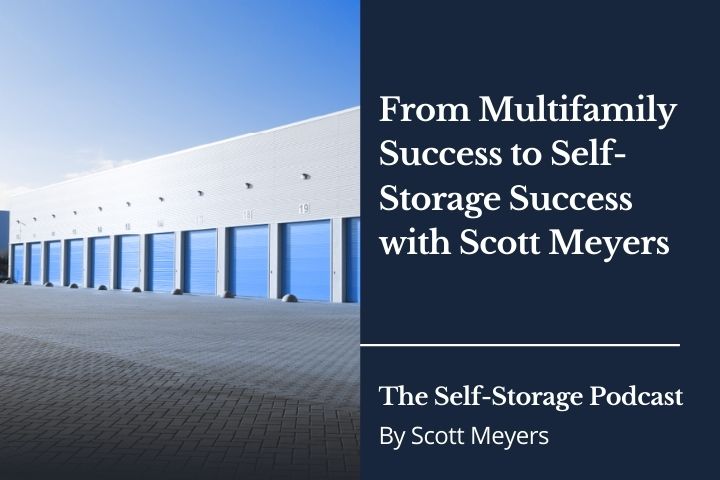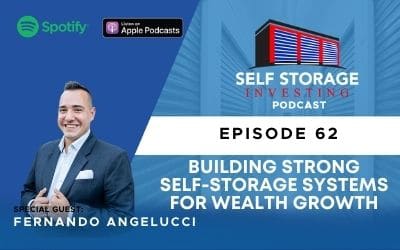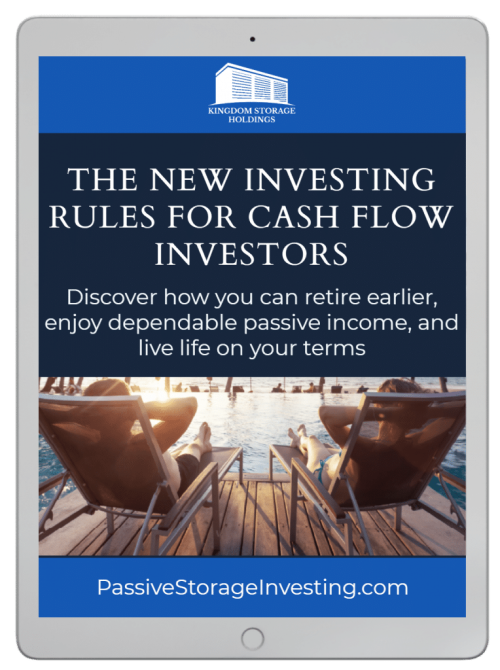The revisions to the SBA rules make it easier for borrowers to meet the 10% equity requirement for loans, allowing seller debt to count towards the full 10% equity injection.
Other changes include the acceptance of Home Equity Line of Credit (HELOC) or cash-out refinance of real property as equity, and the simplification of debt refinance.
And a newly implemented rule limits loan terms for partner buyouts to 10 years.
WHAT TO LISTEN FOR
5:18 Use of HELOC and Cash-out Refinance for Equity
6:30 Clarification of SBA 7(a) vs. 504 Loans
17:40 SBA’s New 10-year Loan Term Limit
26:21 REITs Management Approval
Leave a positive rating for this podcast with one click
CONNECT WITH GUEST ANNE MINO
Website | LinkedIn | Email
CONNECT WITH US
Website | You Tube | Facebook | X | LinkedIn | Instagram
Turn your savings into a wealth-building machine.
Scott Meyers introduces Donnell and Angelique Stidhum, a dynamic duo dedicated to empowering individuals through financial literacy. They share their journey and strategies for leveraging self-directed 401(k)s, real estate investments, and other financial tools to achieve financial security and freedom.
Highlighting the importance of community and clear goals, the Stidhums provide a roadmap for transforming traditional retirement accounts into a powerful wealth-building machine. Tune in to discover how to take control of your financial future and achieve your dreams.
WHAT TO LISTEN FOR
1:31 The Importance of Financial Literacy
2:17 Donnell and Angelique’s Self Directed Journey
17:48 The Power of Self-Directed Investing
19:33 Setting Clear Financial Goals
Leave a positive rating for this podcast with one click
GUESTS: Donnell and Angelique Stidhum
Email | Website | You Tube | Facebook | LinkedIn | Instagram | TikTok
CONNECT WITH US
Website | You Tube | Facebook | X | LinkedIn | Instagram
Follow so you never miss a NEW episode!
Leave us a rating and review on Apple or Spotify.
Episode Transcript
Angelique Stidhum (00:00):
A lot of that comes down to information and having access to information. So at the core of everything that we do, we want to make sure that other people have access to information so that they too can have and achieve their goals.
Announcer (00:20):
This is the Self-Storage Podcast where we share the knowledge and skills from the industry’s leading investors, developers, and operators to help you launch and grow your Self storage business. Your host, Scott Meyers, over the past 18 years has acquired, developed, converted, and syndicated nearly 5 million square feet of Self storage nationwide with the help of his incredible team@Selfstorageinvesting.com, who has helped thousands of people achieve greatness in Self storage.
Scott Meyers (00:57):
Hello everyone, and welcome back to the Self-Storage Podcast. I am your host of Scott Meyers, and in today’s episode we have Donnell and Angelique, the dynamic duo who are going to talk about ways to, well, ways that they empower our students to come to our self-storage academy, as well as all of our clients and our community, how to gain financial freedom by ways of tapping into self-directed 4 0 1 Ks, real estate, 4 0 1 Ks, and other financial means, and making them more financially literate to be able to achieve their dreams and goals in self-storage. So with that, Donnell Angelique, welcome to the show. Thank you.
Angelique Stidhum (01:31):
Thank you. Thank you so much for having us.
Scott Meyers (01:33):
Well, we’ve been working together for a number of years, and so thankful, first of all, well way overdue in order to, first of all, way overdue in having you on the podcast, but we’ve been having these conversations and you’ve been helping so many of our folks in our community to do just that. And so I would be remiss if I didn’t give you both an opportunity to talk a little bit about your journey, because an incredible one, and also being a team in the business. Tell us a little bit about, well, first of all, what it is that you do, and then what was the genesis of how you got into this side of the business of showing people truly how to tap into I think, this hidden areas of these hidden pockets of capital that they didn’t know they had access to?
Donnell Stidhum (02:17):
Well, I’m a fan of letting the beautiful ladies go first. Just real
Scott Meyers (02:20):
Quick. I am as well, Donnell. Very good choice.
Angelique Stidhum (02:23):
Okay, well, I thought you were going to go first. Really, Scott, we have our own story of how we got started and why we were able to achieve the results that we have today. A lot of that comes down to information and having access to information. So at the core of everything that we do, we want to make sure that other people have access to information so that they too can have and achieve their goals. Financial security is different than a lot of the other buzzwords that a lot of people use, financial freedom, et cetera. Our goal is to contribute to that and help more people realize a story like we’ve had that opportunity. So the fact that we can do it together I think is just an honor, a privilege, a blessing. The fact that we work together and we’ve learned how to do that is one thing, but being on the same page, being on board, having someone who may not have been completely on board in the beginning, that’s also a part of our story. We see that a lot inside of this community. Everyone has goals, but they’re not writing on the same pages. That’s essentially where it all started from. The pursuit of that and finding the solutions is where Donne led both of us to where we are now today.
Donnell Stidhum (03:43):
Yeah, it’s largely built around our own individual story as to why we educate others, meaning we were on our own journey to identify what freedom looks like, how to leverage a lot of the tools that we’ve always had, but no one really educated us on how to leverage and use those tools to build wealth, generate income, get to a goal. And what’s so awesome about this partnership is I think at my core, I’m just a math teacher. If you pay attention to what I’m doing, I am taking an equation, dissecting that equation, putting that equation back together. And as a result, I’ve learned how to articulate how that equation went together. And so I share, and it’s a fire hose of information, and what my wife does is she kind of ratchets me back down and kind of brings the, I’ll call it the real life detail to help connect dots that maybe I have overlooked.
(04:37):
Because in my mind it’s a simple mathematical equation, whereas in truth, there is a real life aspect here that has to be connected. And I think this partnership, what it does is it brings those pieces all together because I think she said it, it’s really about community. It’s really less about, Hey, how can I use my retirement account to be able to invest in things that Fidelity won’t allow me to invest in? It’s really more about, Hey, there’s this community that we are developing, that we are generating that if you lay these pieces out, you have an opportunity to look at these pieces individually and figure out how they can go together to help you get to your goal. We talk about being many ways to 10, meaning Angelique and I equation may look like one plus one plus eight, but yours may be three plus three plus one, meaning we’re going to lay out all of the opportunities and all of the pieces to this puzzle and allow you the opportunity to pull together what makes the most sense for you.
Scott Meyers (05:42):
And that’s what I’ve appreciated about the approach that you take. And as we’ve said, when we introduce you at our academies and our masterminds said, Hey, this is a coveted stage and we don’t just let anybody into our room and into our community and to talk to our tribe because you first of all have to care. And then second of all, you have to have a purpose and a goal in mind that is not yours. It is for the success of our folks. And we’ve seen that over and over again. And then the approach that you take with them is, well, as much as you can do in the hour and a half that we typically give you, but then over the course of a few days. But what happens is behind the scenes and is doing, as you just said, the math equation, going through the math exercise with everybody individually. And so if you could so people understand a little bit more about what we’re talking about, let’s walk through that process. If you could briefly, the steps that you take these folks down so that they can not only achieve their goals, but where do we start? How do we lay those pieces out?
Donnell Stidhum (06:38):
Yep, absolutely. And so it really starts here. It starts with a simple question. What vehicles are you investing your hard earned money in today to help you reach your goal? Meaning it first starts with what’s the goal? Let’s say the goal is financial freedom. The goal is to be able to retire comfortably. The goal is to be able to at some point stop working and be okay. Well, the first question is what do you have in place today? And in most cases, people have the traditional IRA 401k, 4 0 3 B-T-S-P-D, traditional, I’ll call it a conditioned approach to achieving wealth in retirement. And then I come along and go, well, have you thought about this as it relates to those traditional retirement accounts, meaning in truth in a short, they were never designed to help you sustain your lifestyle. Never. And so what I come along and do is I lay out how those same vehicles can actually be leveraged to actually help you hit your goal, how by taking them out of the structure that they’ve been traditionally in.
(07:45):
And ultimately what I mean is it’s about getting your money out of the market, out of the stock market, out of the casino, and being able to structure your traditional retirement accounts so that you can invest in non-traditional investments. And then we break down what those non-traditional investments opportunities are and how to then structure your previous employer retirement accounts to be able to invest in those things. So it’s really ultimately helping them understand where they are and then building a path to what this can look like if you were simply structured properly. Name of our company is Self-directed. Self-directed retirement plans. What does self-directed mean? Self-directed is just about control. So here’s an opportunity for you to be able to take control over your retirement dollars to be able to invest in what you want to be able to accomplish your goal.
Scott Meyers (08:34):
And typically when I introduce you both, we talk about the genesis of our relationship and how we met each other and the need essentially that we had is to bring an educator in for somebody to talk about how our investors as they grow and scale their self-storage business, eventually we all run out of cash. Cash is the fuel for the engine that allows us to grow scale. And so at some point we need to get good at raising private capital and looking for other means and other ways and other resources. And so another piece of what you do or really the same piece of what you do is allow people to invest passively into syndications and to funds and private places by way of their self-directed vehicles as well. But then the real benefit and storage nation and storage nation, in all candor and honesty and our surveys, I’d like to say that everybody loves Scott or our team at the end of our 3D academies in our masterminds, but it is always Donnell and Angelique that when asked what is the best session, the one with the most takeaways or they had the greatest impact and it is because of the dollars that you are unleashing that they did know that they had in these former programs, former retirement vehicles that they had with their other employers and other means so that they can actually invest in their own deals and their own business first before going out and then seeking private capital from other folks as well.
(10:00):
So it’s more than truly just looking at what I felt in the beginning is tapping into other folks, other people’s money to be able to grow our business, but really empowering the folks themselves to look within first because that’s where the greatest profits are, is if we can invest passively with our own money, let alone actively. Angelique, would you explain that any differently or how would you maybe put a bow on that or be a little more succinct about my big long description about what you do? For our folks,
Angelique Stidhum (10:28):
This is probably the highlight point for me is investing passively. We like mailbox money, period. We do not want to have to be responsible for pushing every dollar that goes out and makes us money. We don’t want to have to have that attached to our time. And so sometimes these passive opportunities are where it’s at. We don’t have to be the expert. We are just the investor. For a lot of people, this gives them freedom and sound of mind that they don’t have to be the expert. When we’ve been at the academy and just talking to people, of course I’m chatty. I love to talk to people, so I’m talking to everybody. One of the most common sentiments that is shared to me and that I discuss with people is the confidence level of can I do this? And if they feel like they have hope that they can learn it because they have the right support. I think that part’s there, it’s very evident with you and your team. The information is here, I have the support to learn this industry. I don’t know that I have control. That’s the one thing that I think keeps people from moving forward when they feel like they don’t have control, they will leap to any area in their life where they do feel like they have control. We all want a sense of control. Being able take control of your finances and your future.
(11:58):
It’s a machine that you get to drive that can be scary for a lot of people as well. So taking some of the risk out of the equation is I think where Donnell really shines in doing the math many ways to 10. If the risk is bigger for you, then how can we restructure this equation so that is there an opportunity so that the risk is reduced? Passive investing for us is where that risk is absolutely reduced. It’s leverage. We’re leveraging someone else’s expertise, someone else’s time, and they’re able to do the work. If you’re asking other people to passively invest with you, it’s the same thing. They’re leveraging you and your expertise and your experience. So I do think that this is a point of leverage, but for a lot of people, they’re looking at an industry going, I’m really looking for passive income. Passive investing may be a term that is being thrown around in here because it’s a vehicle towards that goal, but what I’m looking for is passive income. I’m looking for a way that I no longer have to trade my time for money. We all want that. We want an exit strategy, and that’s what I would say would probably be the most common conversation around this topic.
Scott Meyers (13:23):
So
(13:24):
Maybe it’s been a while since I think we’ve visited that concept of passive income and passive investing. So in terms of the folks that come to our academy, they’re typically looking at, okay, exhausting my cash resources so that I can generate the income that I want so that I can either quit my W2 job or bring my spouse home or refund my retirement that I lost many, many years ago, whatever that looks like. And that seems to be the first goal, but there’s also folks that come to our academy and just folks that you talk with on a regular basis that the goal of passive investing and passive income, their freedom goal or the freedom number is I want to be able to be earning enough cash cashflow on a monthly basis or an annual basis from distributions and from my investments that it replaces my active income so that I can, once again, you’ll get to that freedom number and be able to go off and do what it is that I want to do.
(14:16):
So similar goals, same goals, we just maybe look at it a little bit differently where some folks come at it as truly passive or maybe they love their job, they love their W2, they love their business that they’re in, but they just want to put their excess capital to work for them so that they can do more, they can invest more, they can give more talk about maybe the various goals that people have and how you then build a framework around helping them to be able to achieve their goals. When they come to you and maybe they either have a plan or maybe they don’t have a plan, what does that approach look like and what might the roadmap look like for any individual that may come to speak with you?
Angelique Stidhum (14:50):
So
Donnell Stidhum (14:51):
Are these buckets of individuals? Usually and especially when I’m at one of the academies that I’m speaking to the room, there isn’t one type of individual in the room, right? Usually there is that real estate investor, meaning that someone who already understands the business, but they’re looking to be able to pool capital together so they could grow that business and grow those whose capital they’re using in a better way. And then there’s those who are sitting in the room not really clear as to why they’re there. They just know they want more than what they have today. And then there are some who are just straight entrepreneurs, never heard of, doesn’t have a 401k or an IRA and had no thought on ever even receiving one. Well, to me, all of those buckets go together and the key is to be able to craft the message show that it is easily received by all.
(15:39):
Here’s what I mean. Just because you may not have a previous employer’s plan doesn’t mean you shouldn’t understand this information that I’m sharing, and here’s why I would think that the objective is to be able to gather and assist and pool as much as you can to be able to help hit your goal, meaning OPM, using the leverage of the use of other people’s money to be able to grow where you want to grow or you want to be able to access your own capital to be able to hit your goals. Regardless, the message is the same. You should understand this information such that you can educate others if you need to or at least send them to the right person. Hey, you know what? I was sitting in this room and you know what? When I drove home after this event and I was watching my neighbors cut their grass, I realized standing to the left and the right of me where these individuals who have no idea as to how challenging it’s going to be for them to be able to stop working or fire their job or hit their freedom number or whatever the case may be, Hey, here’s an opportunity maybe you’re not aware of, for you to be able to pull your funds together to be able to hit those goals.
(16:47):
So receiving this information to be able to educate others on how to be able to hit objectives as well, I think is a strong kind of focus or piece as far as what we lay out also. But the key is being very specific and detailed around what does this actually mean when I say you’re able to invest in non-traditional investments? What does that even mean? What that ultimately means is, hey, instead of the mutual fund stocks and bonds, you are used to being able to contribute your IRA 4 0 1, K four three B into did you know that if you just simply make some small tweaks into your previous employer’s plan, you can actually take those same dollars and invest outside of the market and have more control to be able to hit your freedom number and have access to the lifestyle that you were hoping to achieve. So it kind of starts there. Also,
Angelique Stidhum (17:48):
I’ll add to that if that’s okay, We say all the time, if you don’t know where You’re, any road will take you there. So we definitely start with the goal in mind, but understanding what answers you’re putting down and where they’re coming from also matter. For some people, when we say, what is the goal? They say maybe something like generational wealth. Well, that’s not really a goal. That is, that’s not something that you can achieve unless you have a number of what that means. So let’s get granular. What would it take for you to realize that goal? What’s the number? What’s your freedom number? What is the amount of income that you will need in order for you to, and what does the machine need to look like in order for you to put a dollar in and it keeps making its own money, right? Forever income. In addition to that, how do you secure that so that it’ll last through generations?
(18:38):
There’s a lot of layers to this, so we try not to allow people to have very vague goals and start peeling back the layers on. Why do you want that? Why is that important to you? What is it that’s going to stand in your way or become more important than this goal? We share a concept and I think you’re reaching for it. We share a concept around the story about a boat. It’s not the movie, the Boys in the Boat, this story, it’s from a book called Will It Make the Boat Go Faster? This story is from the 1997 Olympics. The British rowing team was known as the worst team. They had the worst reputation and people made fun of them all the time. Why do these people show up? They lose every single time. They got really tired of losing. And it was this one year where they had decided deciding meaning to kill off all other alternatives.
(19:33):
It was no longer negotiable for them to lose. They were asking themselves one question. This became their mantra, will it make the boat go faster? Everything that we do from what we eat to how much we sleep, all of those small decisions that we make, will it make the boat go faster? If they could not answer yes to this question, then it was non-negotiable. They could not do it. And they committed to that, right? Is they knew where they were going and they knew what they were going for. If we don’t have something like that, then we can go to all the academies, we can listen to all the podcast, we can sign up for all the workshops, but we’re not going to take action because we don’t yet understand how it’s going to help our boat go faster. It’s also the smaller decisions that we make.
(20:22):
Some of those are our relationship with money or our relationship with our future version of ourselves that we say we want to achieve. But if we’re not willing to do the work, then it’s almost like saying the destination is negotiable. So for those who are wanting to do some of that work, for those who maybe haven’t peeled back some of those layers, we’re not tough love. We understand that money is emotional more than it is strategic. So first you have to be able to peel back those layers and a lot of that happens inside of the home. So those conversations and making people feel comfortable that this isn’t taboo to talk about, this is necessary in order to take action and reach your goals. So we just invite people welcome and bring more people along, and let’s normalize these conversations because we have to start doing things in non-traditional ways because it can no longer be taboo to have these discussions. We need financial security and it’s required to take different steps to achieve that income.
Scott Meyers (21:34):
And there’s so much to unpack there, isn’t there? Angelique, we could go and talk about the heart behind it, the why behind it, and as we talk about in our academies, what is your moonshot, your big, hairy, audacious goal. And if we don’t have a number level something to work towards or something that we just identified and quantified, there’s no way that we can do the math and reverse engineer it back to what are the annual goals then that we’re shooting for? What are the quarterly goals and then what are the monthly, weekly, and minute to minute activities that we need to be doing, just as you mentioned, to be able to roll up to achieving that goal. So it truly does start with that, and otherwise you have no idea whether you’ve hit the mark, whether you’re getting any closer to the bar. And if you’re not feeling as if you’re fulfilling each and every step along the way, then discouragement sits in and then all of a sudden you forgot, Hey, why is it that I’m doing this?
(22:28):
And complacency comes into place and then nobody achieves anything at that point. So let’s talk about the folks we highlight. We like case studies because you get to kind of test drive with somebody else’s money and experience the success of other folks and seeing the mistakes they made along the way. Talk about if you would, this is a question for either one of you talk about a case study, talk about a success story where some folks came to you and then maybe they didn’t know what they were looking for, or maybe they were clear on what their moonshot was of their goal and how you helped them to achieve it, and maybe a little bit of detail and a little bit of color as to what that plan might look like for someone.
Angelique Stidhum (23:07):
Yeah, we have a lot. You want to go ahead?
Donnell Stidhum (23:10):
Yeah. Well, I think just yesterday I had, and this is something that we run across a lot, and I’m curious as to how you deal with some of these challenges as well, Scott. It’s related to the spouse dynamic, meaning you’ve got one spouse that’s been watching your podcast and been to the academies and for whatever reason, gets it, understands it, and is ready to move forward, but then they have to transition and educate their spouse, or the spouse ends up coming to the academy, arms folded, mouth twisted and waiting to be sold on some hair-brained scheme that their spouse has now brought them to, right? So I was on a call just yesterday with a couple who she had been following us. She’s been on the live, she’s participated in the chat, she’s received all of the free content. She has a fairly good understanding of what it is and how we educate, but her husband has no idea and did not want to participate.
(24:08):
So he happened to show up to our Zoom call. So I do all of my meetings over Zoom showed up to the Zoom, and her issue was, Hey, I get it. I’m ready to move forward. I understand how to take, the objective is to be able to take control over our previous employer’s retirement to be able to help us not just knock down some of these debt related issues that we have, but also create enough cashflow so that we can start transitioning our funds to be able to invest in syndications, to be able to invest in non-traditional investments, to be able to put our money to workforce so that we can hit our goal. And I just politely asked her, I said, do you mind if I focus my attention on your husband? And she goes, sure, of course. And so I started out with, okay, I’m assuming you and your spouse have goals.
(24:54):
What are those goals that he rattled them off? I want to retire early. I don’t want to work forever. And he has a pension, but his concern is if something happens to him, will his wife be okay? And I stopped him and I said, well, walk me through. Let’s say today is the day that you retire. Walk me through the vehicles that you have already set in place to be able to hit that objective. And he started with his company’s retirement account and he’s got a rental property. And then he paused and he goes, you know what? That’s about it. And I said, okay, what are those actions? Because I get it, you have a time horizon. Let’s call it 10 years, let’s call it 15 years. You have a time horizon. What are you doing between now and that 15 year time horizon to be able to hit that goal, to be able to retire your wife or to make sure she’s okay?
(25:44):
And again, he paused. He goes, other than my company’s retirement account, that’s about it. And I think there’s the end, right? There’s the end to say, okay, well, let me share with you some opportunities that may be available to you that you may not have known. So what I broke down to him was, let’s say you have a million dollars in your current retirement account, and today is the day you retire, how much income would you expect? And if I’m a millionaire, I expect a hundred thousand dollars. Wouldn’t we all? If you’re a millionaire, I would expect that that’s going to produce at least a hundred thousand dollars of income for me. And I broke down why his traditional company’s retirement account was never designed to produce income. It’s designed for net worth. It’s designed to grow as large as it could possibly grow, but it is was never designed to produce incomes.
(26:32):
I broke that down. And then what I shared with him was, if you have a million dollars in your retirement account today, that equates to $40,000 taxable in income. Is that enough? No. There’s a gap. How much is that gap? Oh, that gap is about $60,000. Okay, what’s your plan today to close that gap of $60,000? Again, quiet. So once we understand, here’s where we are now, let me share with you some opportunities to help you hit your goal. Here’s how you can free up cash flow where you are today. Hey, you’ve got a previous employer plan that’s stagnant, sitting there doing nothing. What if you had more control over those funds to be able to do the things that you like to do? You’re already a real estate investor. You understand how that process works? What if you could take some of your previous employer plan and put them to work?
(27:19):
Could you do better than the mutual fund stocks and bonds that they’re currently in? And it’s like, well, yeah, I can. So again, it’s helping people. Well, identifying where people are and then breaking down because of where they are. If this is their goal, how are they going to get there based on where they are? And then just adding small pieces, small tools that they can put in their tool belt to be able to help hit their goal. And once you, and I’m a common sense guy, it doesn’t have to be super technical. You don’t have to dig into the details of how a previous employer plan become a self-directed 401k. That’s not the point. The point is it’s possible. And when it’s possible and you have control, now you are able to, I’ll call it, put yourself, put your family, put your money in a position to be able to actually hit your goal. And then once we bridge that gap, it’s game over
Scott Meyers (28:11):
Well, and that truly is at the heart of what we do. And I believe what separates us, we were the first to build a self-storage community and to educate people on how to go out and invest. And we’re the first mastermind in the industry and many others. But I believe our state power and the reason why people are continue to be attracted to us is that we’re not looking to sell books as we go, used to call it books and tapes, but educational materials for the sake of earning a dollar. It’s to build a community of like-minded individuals that are all rowing in the same direction where we’re sharing deals and it’s not going out into the public sphere, but they’re kept in our community. And we’re teaching people the right ways of finding and evaluating these projects so that they can bring ’em to our community and they can either wholesale them or we can do partnerships.
(28:57):
And we have built our own ecosystem where people are trading deals and doing business and doing business together. And collectively we are. And we have built the largest community and the largest tribe of folks that are doing that. But it doesn’t come without having another goal in mind. And it is not just that, but I think people are attracted to us because of the people like yourselves that we bring in the room and our ultimate goals, which is we tie 10%, we give back and we build houses in Mexico, and we do good with what we are blessed with. And the reason why we continue to go we don’t have to is because we know that we can make a dent in the world. And you see that on day two when we get together and have dinner together and we discuss, people can openly come up to the mic and share what are their goals, their BHAGs, their moonshot, and we know we got the right people in the room and then include yourselves and Angelique. I mean, I’ve heard it a couple of times now, but even after the first, what your goal is something that will, I know gets you up in the morning and we’ll continue to keep you getting up early in the morning and working as hard as you do. And so if you wouldn’t mind, would you share that goal with the C community?
Angelique Stidhum (30:05):
Yeah, sure. My moonshot, my moonshot is that I can witness what it looks like to be born with financial security to be born knowing that you were thought of far before you were ever a twinkle in anyone’s eye that you were provided for. And so when I’m struggling with, gosh, I really don’t have to do this today, or I’m struggling with staying focused or making decisions, sometimes I ask myself, you don’t know her name yet, but what does she need from you right now? What’s the version of you that has to show up today in order for her to meet? That is reality, right? I say granddaughter because we have four boys. And so in my world, my moonshot is that I get to have a granddaughter, and I’m okay with saying that we will love the grandsons just the same. But I was not born into a family like that. And I don’t know what it feels like to have to be financially, to be secure out of the womb and to be provided for in a way that is not because you’re here in a way that is, we created a place such as this just for you. And that’s what I hope. So that’s my moonshot
Scott Meyers (31:42):
Donnell. What would you add to that or what is your individual moonshot?
Donnell Stidhum (31:47):
And we’ve covered this a lot as well. It’s actually become a mantra even on our channel. It’s about the WTF moment. And people get confused when I state WTF because they think one thing. But from our perspective, it’s this. It’s being able to make the proper adjustments in your lifestyle so that you could help or assist your family in generating wealth. So the W meaning wealth and wealth is not a number. And as you generate that wealth, what you’re doing is you’re reclaiming your time because as of today, who controls your time? Is it some W2 employee? Is it some job that you’re not? You may be great at it, it brings you sufficient income, but this is not what your purpose is. So reclaiming your time, having more control over your time so you can do what your purpose or what you are actually put here for.
(32:40):
And then it’s the freedom piece. And what is freedom? Freedom again is not a number. Freedom is the ability to do what you want to do when you want to do it, how you want it to be done, and with whomever you want to do it with. So it’s putting ourselves in a position to where we can achieve our WTF moment without fail. And I think that’s as far as a moonshot that is not just my moonshot, but it is also what we’re trying to educate our community around and being able to hit their WTF moment as well.
Scott Meyers (33:10):
Well, storage Nation, you have been chatting with two of my favorite individuals on the planet and Danal and Inch linkin, and I’m so thankful for them and all that they’ve done, not only in our lives, in the lives of my kids and setting up their accounts and helping them to get on their path to their WTF moments as well, but for dozens and dozens, hundreds now of the folks that have come through our academies in our masterminds, we’ve been talking an awful lot about the why on this podcast, not so much getting into the how to, and yes, that matters. But what I would like to do folks, is reach out to Donelle and Angelique. They’re going to provide their contact information and they have the tools and the resources. They’re not financial advisors, they’re not financial counselors. They’re going tell you what to do or put you into their investment vehicles.
(33:59):
As a matter of fact, it’s just the opposite of that. They’re going to look at the resources that you have and just show you different ways that you can be able to maneuver and to be able to achieve your goals. And they do that with a consultation free of charge, free. You go down the right path. And if it’s something that they can help you with in the future, then so be it. And if it’s a phone call in which they unlock a few things and send you on your way, they’re happy to do that as well. And I’ve seen them do that dozens and dozens of times as well. So Donnell, Angelique, what is the best way for Storage Nation to reach out to you and schedule a call to see if they’re on the right path?
Angelique Stidhum (34:32):
Yep. Well, they can go to sd retirement plans.com. They can also a little easier to remember self-directed info. They could go there as well. We have a ton of free resources and access to the calendar right there. They can book their call there. They can also call or text (602) 560-7311.
Scott Meyers (34:55):
Okay, guys, thank you so much for your time. I appreciate you too, both so much. And I’m looking forward to the next time we’re in the same room together, which isn’t too far away. It’s only in a couple of months. But in the meantime, storage Nation, please reach out and chat with Donell and Angelique. And if you haven’t scheduled time to come to one of our self-storage academies to put all of this together, this is just one more piece of the puzzle for allowing you to reach your dreams and your goals. Another tool, another resource, another arrow in your quiver, but also a very critical one as we continue to build this community and to continue to build this tribe, our ecosystem, that it continues to grow and grow so that we can begin and continue to do more and more deals together so that we can make our own dent in the world, in our own world, as well as the world at large. So you’ve been listening to two of the best of the best in helping people to achieve that. And so guys, thank you once again for your time.
Angelique Stidhum (35:47):
Thank you so much for having us. We are so honored, Scott.
Donnell Stidhum (35:50):
So much appreciated, Scott. And as always, can’t wait to see you again,
Scott Meyers (35:55):
Storage Nation. We will catch you on the next one. Take care.
Announcer (36:02):
Hey gang, wait three things before you leave. First, don’t forget to follow the Self- Storage Podcast and turn on your notification so you never miss another episode. And while you’re there, please leave us a five star review if you like the show. Second, be sure to share your favorite episodes and more via Instagram, and don’t forget to tag us. And lastly, head to the links in the show description and hit follow on Twitter and Facebook to get a front row seat as we grow and scale our business and bring you along with us.
















